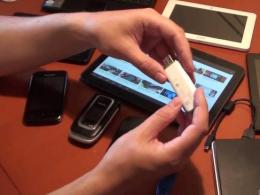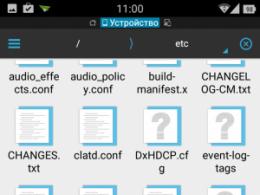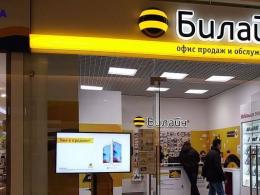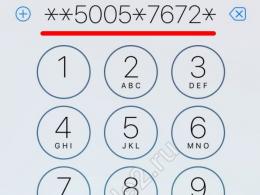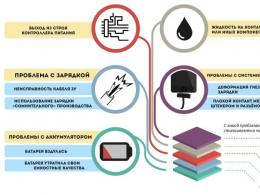Disk or network resource unavailable what to do. No access to network folder
The concept of "label" is known to modern man mainly due to computer technology. It means a pointer to some object. Such an object can be a file or folder, and often various properties are connected to shortcuts. For example, they give a command to the program to run in full screen, or with a specific resolution. In Windows, this type of files has taken root so well because of the presence of the Desktop. At least once every experienced user has experienced errors when working with shortcuts, how to fix them? It won't hurt to figure it out.
To properly troubleshoot problems with shortcuts, it is worth identifying the cause of the occurrence.
The device of this type of files cannot be called complicated. In fact, this is a small document in which a link with parameters is written. It is not difficult to recognize this type of file - it is an icon with an arrow at the bottom (although in some "assemblies" of the OS windows arrows may not be). Most modern operating systems support them at a very deep level. You can get acquainted with the contents of the label by calling it context menu and clicking "Properties".
Here you can see several tabs:

Possible problems and solutions
Most often, when working with such links, one banal problem occurs. The object referenced by the file has been moved, deleted, or lost by the system. Or it can't be started. It's not uncommon for a user to try to call something that doesn't already exist at the end address. This is the most typical error when working with a label.
This problem has several solutions:
- Just remove the label. It must be remembered that it does not play any critical role in the system. It does not record important information, except for the location of the file or folder. That is, by doing this, you will not delete an important document that you are used to finding by double-clicking on it.
- Rewrite object reference. In the corresponding tab, simply replace the address of the target object with a new one. To do this, find a new object and in its "Properties" look at its location. Then copy this data to the shortcut properties.
- If the object has been moved, the easiest way is to create a new reference to it. To do this, just call the context menu desired file or folder, then click "Send" - "Desktop". This will allow you to quickly access the right document directly from the desktop.

Errors of this kind are a small problem. Of course, if it is not caused by another, larger problem. If you can't find what you're looking for by the name next to the icon, try using Windows Search.
Other problems
It cannot be ruled out that a virus is to blame for problems with links to files. This is possible if a good antivirus package is not installed on the PC. Run a comprehensive scan using Microsoft Security Essentials or Kaspersky. Then try the methods above.
Eventually
Label issues are not that hard in and of themselves. If you have basic Windows skills, you will certainly be able to cope with them without difficulty. And if the root of the problem still could not be eliminated - contact the comments, the users of our site will tell you the right solution!
22.03.2016In this article, we will discuss a popular problem with not working shortcuts. After reading it, you will find out why the shortcuts do not work correctly and what needs to be done to correct this situation.
And at the end, it will be possible to consolidate the theory by watching a video instruction with a practical example. So good luck to all friends, do not be afraid to correct mistakes yourself.
So, friends, if you have not yet found yourself in a situation where suddenly all the shortcuts on your computer start acting weird. Really weird, let's say you start the music player, and the Word opens. Trying to launch a browser, but notepad opens. The situations are varied, but the essence always remains the same, when you try to launch the shortcut of interest, the “left” program comes off or nothing opens at all.
This always happens due to a failure in the settings of your operating system, as a result of which it does not work correctly and does not perform the tasks you set. Those guys who have already been interested in this or have gone through a similar case know that this situation is called a failure of file associations, shortcuts.
My shortcuts stopped working, why?
For those who are not in the know, every file on your computer is opened using a specific program, and if you try to open it with the wrong program that is not designed for this, most likely you will see a pop-up error or incomprehensible scribbles on the monitor.
This happens due to the fact that each file has its own format, called its extension. For example, you have probably heard more than once that songs are recorded in mp3 format, pictures in jpeg format, and movies in avi. All these extensions allow the user and the operating system to understand what kind of file is in front of them and what program it needs to open.
I lead all this to the fact that shortcuts also have their lnk extension. And if the operating system receives a command to open the lnk extension using notepad, then all shortcuts on your computer will automatically open through notepad. As a result of changing the settings, shortcuts can be opened by any program on your computer, but they will not work as intended.
Most people, once in this situation, immediately begin to look for a solution to the problem, this is of course good. But I would first recommend understanding the causes of the failure. After all, if you do not understand what is happening, then in the future you can “stumble” about this situation ad infinitum.
So first sit down, calm down, think for a minute about what you were doing before the shortcuts stopped working. I think you will almost immediately determine the cause and remember forever that you do not need to do this. And I'll give you a little hint. Most often, shortcuts are opened by the same program due to your negligence, you yourself by chance and specifically set a default program for opening a file unknown to you.
To do this, just right-click on the file and select the “Open with” pod in the drop-down menu, while choosing the program and forget to uncheck the settings: “Use the selected program for all files of the selected type”


This is how shortcuts and programs “break” so easily.
Of course, besides this, there is still a high probability of catching a virus that, without your intervention, will make all the necessary settings, and shortcuts will also stop opening, as expected.
How to restore shortcuts? How to restore label associations?
There are several ways to return the system to a working state and not torment your brain. All tasks come down to changing the settings that are registered in the registry.
Therefore, if you are an excellent programmer, then it will not be difficult for you to go into the registry and manually edit it to a working state. But, most likely, it is impossible for an ordinary user to do this.
To automatically enter necessary settings to the registry, any user who does not even understand anything should download the finished registry file and run it on their computer.
After you have downloaded the archive to your computer, you should find the registry file you need, namely, choose for which operating system restoration is underway. Decided? Now just double-click on it and confirm the changes in the system, after which we must reboot the system.
You can clearly see at the end of the article, there is a video instruction with a practical example for this.

If there is such a situation that after automatically making changes to the registry, the shortcuts still do not work, then we are preparing for a little adventure, but do not worry. You just need to manually start the registry and remove the extra section from there.
To start the registry, press the keys on the keyboard at the same time WIN+R(the WIN key is a button with a Windows flag) a command input panel will open in front of you, where you must enter the word "regedit"

After entering the command, click "ok" and a window with the computer registry opens in front of us

Now we need to find the section that made changes to the registry and delete it, for this we are looking for a section with the name UserChoice
It is located at:
HKEY_CURRENT_USER\Software\Microsoft\Windows\CurrentVersion\Explorer\FileExts\.lnk
Once found, simply delete and restart the computer.
Shortcuts do not work, what should I do if the shortcuts do not open?
Write in the comments if the article helped to fix the situation with non-working shortcuts.
Recently I helped one friend with such a problem: all the shortcuts began to look the same and are opened with a notepad. I read the comments of people on the Internet and many are horrified by this problem :). In fact, everything is solved quite quickly and easily.
The concept we've come across is called label associations. What are associations?
Windows stores such a table, which describes which program to run when accessing a particular type of file. It is logical that when I decide to open a picture, it is the Photo Viewer that starts, and when I decide to open a song, for example, Winamp starts. So, in our situation, these very associations have gone astray.
But, before solving the problem with the shortcuts, make sure that the problem is in them. What else could it be? When we run a file, Windows determines which application it is associated with and launches this application, and this program opens the file.
Labels are a little different. A shortcut is just a link to a file. That is, by clicking on the shortcut, an application is launched that should open this file. And if the application file associations - exe, are also knocked down, then the problem is not only in the shortcuts.
In this article, we will deal only with the case when the problem is related to label associations. So how do you figure out if the problem is exe files or labels?
Go to C drive, Program Files or Program Files x86 folder, and try to run any program like Skype. To do this, you need to run the file at: c:\Program Files (x86)\Skype\Phone\Skype.exe. If Skype starts up, then the problem is really with the shortcuts.
It is a generally accepted norm and you will not surprise anyone with their presence. Due to the availability of the Internet connection, various online services are becoming more and more popular. Some of the most popular are network folders and remote resources, organized both on your home network and provided by your Internet provider. Most often everything works as expected, but from time to time there may be errors that prevent full operation, which regular user doesn't know how to solve. One of the most common errors is "No access to network folder". Some of them may be indicated by a numeric or alphanumeric code, such as 1231 or 0x800704cf. These problems can be caused by various factors. In this article, we offer you to deal with all the reasons, as well as offer ways to solve them.
No access to network folder
Let's imagine that you have several computers between which you want to configure home network so that you don't copy the necessary files all the time. In this case, you need to create a folder on one of the computers, make it public so that it can be accessed from any other device with Internet access. It can even be a smartphone or tablet.
One of the most common mistakes when working with remote folders- there is no access to the network folder, while the error code 0x800704cf may be issued. You see a shared network folder in Explorer, but when you try to open it, you get the message "No access to resource." The exact text of the message may differ depending on the version of the operating system. What are possible reasons such a problem? There may be several of them:
- A single user has not been granted access rights to a folder located on the network.
- The user does not have permission to access the network resource at the operating system security level.
- The user generally does not have any permissions to access the resource.

Every problem can be solved. Let's take a closer look.
Configuring access to a network folder for each user
All settings must be made on the computer or resource where the contents of the folder are stored. To configure user access to a folder, you must:
- Go to computer management (depending on the version of the operating system, click right click click on the icon My computer on the desktop Windows desktop or by clicking the Start button, then select Manage or Computer Management) and select the item Shared folders- Shared resources.
- Find a folder in the list of resources that you cannot access and see its location on your hard drive.
- Open File Explorer and find the desired folder ( Windows users 10 can perform further actions without going to Explorer by simply right-clicking the mouse directly in the Computer Management utility menu).
- Right-click on it, select Properties - Access - Advanced settings - Permissions (or Properties - Permissions for a share).
- You will see at least two items - Administrators and Everyone. Hover the cursor over the All item and make sure that all items in the Allow column are checked ( full access, change, read). If there is a tick in the Deny column next to some item, you should remove it from here and put it in the Allow column.
- Confirm the changes by clicking Apply - OK, and then try again to use the network resource.

Right click on "Computer" and select "Manage" from the context menu
Configuring access to a resource at the system security level
Sometimes it happens that at the security level of the operating system, access of third-party users to a network resource is prohibited. To fix the issue:
- In the Properties menu, open the Security tab and click on the Edit button, then Add.
- In the "Enter the names of the objects to select" line, capitalize All and click OK.
- Once you're redirected back to the list of groups and users, hover over the newly created Everyone group and check off the actions you want to allow. The checked default items are enough to read data from a remote network resource.
- Click Apply - OK - OK and try to access the network folder again.
Error 1231 occurs when trying to connect to the internet
Error 1231 occurs when a Windows computer cannot access resources located on a remote server. Most often occurs when an Internet provider provides access to an international network using VPN technology. It may also occur when you try to access a service provider's local resource. network access. If access was and suddenly disappeared, this problem may occur for one of the following reasons:
- problems on the part of the provider;
- interruption of communication between the subscriber and the server;
- breaking network card computer;
- failure of network card drivers;
- the security system of the operating system is blocking the VPN connection;
- incorrectly established or disconnected LAN connection;
- actions of virus programs.
First of all, you should check if error 1231 occurs due to the fault of the Internet provider. To do this, you need to launch the command line (Win + R - cmd, or right-click on the Start button - Command line) and enter the following command:
net view \\domain:domain name,
where domain name means the address of the server that the provider provided you to connect to world wide web. If issued " System error 53. Network path not found", then the problem is on the part of the service provider. In this case, you should contact technical support.
If such an error does not knock out, you will have to look for the cause in your computer or laptop on Windows. What can be done to fix error 1231?

Conclusion
We hope that we have helped you with solving the problem of accessing network resources with codes 1231 and 0x800704cf. We are confident that if you follow our instructions exactly, you will be able to solve everything yourself. In the comments, please indicate whether you managed to deal with the issue without the help of specialists.
In the process of working with a computer running Windows, the following problem may occur: when you click on a shortcut to a disk or network resource, the system displays a warning that the drive or is not available to which the Ink shortcut refers. In most cases, this problem is not difficult to solve.
If you open a disk or resource through a shortcut, which, for example, is placed on the desktop, then the error “The disk is not available or network resource referenced by " occurs because the address specified in the shortcut does not match the actual path.
To make it clearer, let's take a concrete example. The user inserted a USB flash drive into the computer's USB port, and since he often uses this drive, he decided to move its shortcut from "Computer" to the desktop. After that, he inserted a USB flash drive into the same port many times and everything worked. However, at some point, the usual USB, for example, turned out to be busy, because of which the drive had to be connected to another port, and this time the flash drive did not open through a shortcut on the desktop, but instead an error window popped up.
The reason for the inaccessibility error of the disk or network resource referred to lnk shortcut in that when the user connected the USB flash drive to the same port, it was always given a name in the system, for example, "Disk G", but since now it is inserted into another USB, it was given a different name.
While working with a computer Windows control the following problem may occur: when you click on the shortcut of a disk or network resource, the system issues a warning that the drive or network share is unavailable that the Ink shortcut refers to. In most cases, this problem is not difficult to solve.
If you open a disk or resource through a shortcut, which, for example, is placed on the desktop, then the error “The disk or network resource referenced by the lnk shortcut is not available” occurs as a result of the address specified in the shortcut does not match the actual path.
To make it clearer, let's take a concrete example. The user inserted a USB flash drive into the computer's USB port, and since he often uses this drive, he decided to move its shortcut from "Computer" to the desktop. After that, he inserted a USB flash drive into the same port many times and everything worked. However, at some point, the usual USB, for example, turned out to be busy, because of which the drive had to be connected to another port, and this time the flash drive did not open through a shortcut on the desktop, but instead an error window popped up.

The reason for the error of the inaccessibility of the disk or network resource to which the lnk shortcut refers is that when the user connected the USB flash drive to the same port, it was always given a name in the system, for example, "Disk G", but since now it is inserted into another USB, it has been given a different name.
In case of network drive, the reason is even simpler - the server is unavailable. Yes, ping can go to it, but there is no connectivity. Perhaps the access settings have been changed or something else.

If an access error occurs, it is more related to the hardware configuration, then when all icons, for example, on the desktop, have the lnk extension, the problem is due to a configuration change in the file association.
It can occur, for example, when the user tried to open a shortcut in some program and, when performing the corresponding action in the application selection menu, checked the checkbox “use the program for all files of this type” by default. As a result of this, shortcut files have become associated with the selected application, which is not able to launch programs by shortcut.
To return everything, as it was possible to use the application Unassociate File Types.
- Download, install and open the program;
- In the search bar, type.lnk;
- Select .lnk from the filtered list;
- Click on "Remove File Association".
As a result of the performed actions, the associations set for this file type will be deleted. Now the shortcuts will open as they should, and the error "The disk or network resource to which the lnk shortcut refers" will not appear.
All shortcuts began to have the .lnk extension, how to fix it through the registry

If you don't want to install third party application, you can troubleshoot INK shortcuts through the registry. To do this, follow these steps:
- Press the key combination "CTRL + R";
- Enter "regedit" and click "Ok";
- Open the category "HKEY_CLASSES_ROOT;
- In the list that appears, find .lnk and specify the value “lnkfile” in the parameters (if there is something else, then you must first delete the old value and only then enter and save the new one).
After that, the shortcuts will work again as they should.
In contact with

